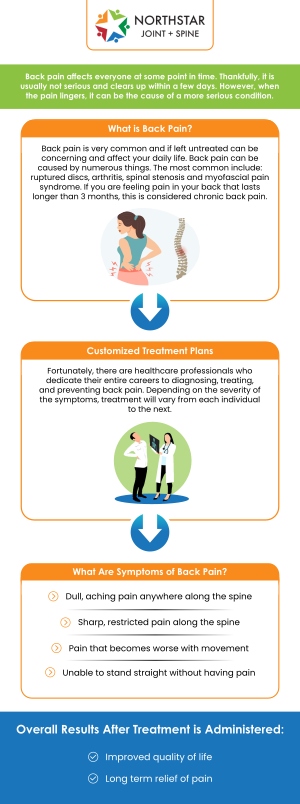Back Pain Symptom: When to See a Pain Doctor?
Back pain can range from mild discomfort to severe, debilitating pain. If you’re experiencing persistent or worsening pain, numbness, tingling, or difficulty moving, it may be time to consult a pain doctor. Board Certified Dr. Robert J. Nocerini, MD, at Northstar Joint and Spine, can help assess your symptoms, diagnose the underlying cause, and provide effective treatment options to relieve pain and improve mobility. For more information, contact us today or schedule an appointment online. We are conveniently located at 7704 San Jacinto Pl Suite #200 Plano, TX 75024.


Table of Contents:
What symptoms with back pain indicate an emergency?
At what point should I be concerned about back pain?
How long should back pain last before seeing a pain management doctor?
What can a pain management doctor do to diagnose back pain?
How can I prevent back pain?
Early Intervention Matters: Consult Dr. Robert J. Nocerini, MD for Back Pain in Plano, TX
Back pain is a common complaint that affects many individuals at some point in their lives. However, it is crucial to recognize when this common ailment points to a more serious medical condition.
Dr. Nocerini advises patients to seek immediate medical attention if they experience the following symptoms:
• Severe back pain with sudden onset, no apparent cause, or no improvement with rest.
• Pain that worsens progressively, even when lying down or resting.
• Accompanying symptoms such as fever, chills, night sweats, or general malaise.
• Numbness or weakness in the legs, feet, genitals, buttocks, or surrounding areas.
• Difficulty with balance, walking, or general weakness.
• Loss of bowel or bladder control.
• Pain that radiates down the legs to the toes, especially if it extends below the knee.
• Nighttime pain that disturbs sleep.
• Pain associated with a recent fall, or a sudden blow to the back.
• Back pain accompanied by chest pain, shortness of breath, or nausea.
These symptoms could point to severe underlying medical conditions.
If you are experiencing any of these symptoms, it is important to seek an immediate medical evaluation. Delaying treatment can lead to irreversible nerve damage or other serious complications.
If you are experiencing persistent back pain lasting more than a week, severe discomfort that disrupts your daily activities, or pain that worsens with movement, rest, coughing, sneezing, or lying down, it’s time to consult with a doctor.
Back pain that radiates down your legs, particularly if it extends below the knee, numbness or tingling in your legs, feet, or buttocks, or weakness in your legs or feet could be signs of conditions such as sciatica or nerve damage.
If your back pain is accompanied by fever, chills, night sweats, unexplained weight loss, signs of infection, or difficulty with bowel or bladder control, it’s crucial to reach out for medical attention immediately.
When it comes to the duration of back pain and the need for medical evaluation, there is no specific time frame that dictates when back pain warrants medical attention. However, we generally recommend seeing a doctor if your back pain persists for more than six weeks, despite making lifestyle changes and using over-the-counter pain relievers. If your pain is severe, significantly impacting your daily activities, or accompanied by other worrisome symptoms such as fever, weight loss, or problems controlling your bladder or bowel, you should seek medical attention immediately.
As a board-certified pain management doctor, Dr. Robert J. Nocerini MD has specialized training in diagnosing and managing different types of pain, including back pain. He can conduct a thorough evaluation to determine the underlying cause of the back pain, such as muscle strains, nerve compression, or spinal disorders, and provide you with the necessary treatment to help you manage your pain and improve your quality of life.
The benefits of timely intervention are numerous. Seeking medical attention for back pain promptly can allow for the identification of the underlying cause early on, prompt intervention, and prevention of further pain and complications. Early treatment can improve the chances of successful pain management, restore functionality, and prevent irreversible nerve damage.
As a board-certified professional, Dr. Nocerini plays a key role in diagnosing and treating back pain. His vast experience and extensive knowledge in the field of pain management allow him to adeptly identify the root causes of back pain using an array of techniques and strategies.
• Physical Examination: Dr. Nocerini conducts a thorough evaluation of the patient’s back, spine, and related muscle and nerve structures. He examines factors such as range of motion, flexibility, tenderness, and posture. He also assesses the patient’s gait and may ask patients to execute simple exercises to evaluate pain during certain movements.
• Medical History: He takes into account the patient’s entire medical history, including details of the onset, duration, nature, and location of back pain. He also reviews past medical issues, surgical procedures, and medications. Lifestyle factors, occupation, and activities that may contribute to back pain are also considered, providing a comprehensive understanding of the patient’s overall health status.
• Imaging Studies: Dr. Nocerini uses state-of-the-art imaging studies such as X-rays, MRI scans, and CT scans for the diagnosis of back pain. These tests provide a detailed visualization of the spine and can uncover issues like herniated discs, spinal stenosis, or tumors.
Preventing back pain is a crucial aspect of overall well-being. Adopting a healthy lifestyle and maintaining good posture is key to reducing the risk of developing back pain. Regular exercises such as walking, swimming, cycling, or weight-bearing exercises strengthen back muscles, improve flexibility, and enhance bone density.
Patients are guided on the importance of posture, not only when standing but also sitting, especially for extended periods. The right posture includes a straight spine, held-back shoulders, and a high head. Avoiding hunching over is emphasized, as it puts stress on the back.
Under our care, patients learn that maintaining a healthy weight can alleviate back strain. A balanced diet, rich in fruits, vegetables, lean proteins, and whole grains, is recommended. Moreover, proper lifting techniques are taught to prevent back strain, emphasizing bending at the knees, not the waist, when lifting.
We also guide patients on the choice of footwear and its impact on back health. Comfortable, supportive shoes are recommended, especially for those spending extended periods on their feet.
Sleep habits are another focus area, with patients advised to sleep on firm mattresses and use pillows to support their head, neck, and knees to maintain the spine’s natural alignment.
Incorporating these habits can significantly reduce your risk of developing back pain and improve your overall health. At NorthStar Joint and Spine, we are dedicated to providing compassionate, expert care for all types of back pain.
Early intervention is key when it comes to managing back pain effectively. At Northstar Joint and Spine in Plano, TX, Dr. Robert J. Nocerini, MD, provides advanced and personalized care to help patients address back pain before it worsens. With over 26 years of experience in Pain Medicine and Anesthesiology, Dr. Nocerini focuses on diagnosing the root cause of discomfort and offering minimally invasive treatments that promote faster recovery and long-term relief. Seeking care early with Dr. Nocerini can help prevent chronic pain, restore mobility, and improve your overall quality of life.
Our goal is to help you regain your quality of life through personalized, effective treatments. Contact us today to schedule your consultation and start your journey toward pain relief and improved well-being. We are conveniently located at 7704 San Jacinto Pl Suite #200 Plano, TX 75024. We serve patients from Plano TX, Willow Bend TX, Frisco TX, Allen TX, Addison TX, North Dallas TX, and surrounding areas.

Check Out Our 5 Star Reviews


Additional Services You May Need
▸ Back Pain
▸ Shoulder Pain
▸ Chronic Pain
▸ Epidural Steroid Injections
▸ Spinal Cord Stimulation
▸ Viscosupplementation
▸ Genicular Nerve Blocks
▸ Facet Injections
▸ Joint Injections
▸ Sacroiliac Joint Injections
▸ Lumbar and Cervical
▸ Facet Medial Branch Blocks
▸ Diagnostic Nerve Blocks
▸ Medication Management
▸ Neck Pain Doctor
▸ Diabetic Peripheral Neuropathy
▸ Headaches
▸ Suboxone
▸ Botox for Migraines
▸ Peripheral Nerve Stimulation
▸ Spine
▸ Joints
▸ Muscles
▸ Bones

Additional Services You May Need
▸ Back Pain
▸ Shoulder Pain
▸ Chronic Pain
▸ Epidural Steroid Injections
▸ Spinal Cord Stimulation
▸ Viscosupplementation
▸ Genicular Nerve Blocks
▸ Facet Injections
▸ Joint Injections
▸ Sacroiliac Joint Injections
▸ Lumbar and Cervical
▸ Facet Medial Branch Blocks
▸ Diagnostic Nerve Blocks
▸ Medication Management
▸ Neck Pain Doctor
▸ Diabetic Peripheral Neuropathy
▸ Headaches
▸ Suboxone
▸ Botox for Migraines
▸ Peripheral Nerve Stimulation
▸ Spine
▸ Joints
▸ Muscles
▸ Bones






